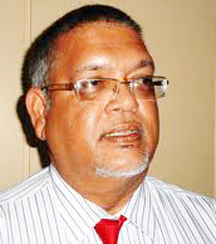Chairman of the Cheddi Jagan International Airport, Timehri (CJIA) Board Ramesh Dookhoo says the airport modernisation project will continue from an allocation of US$20 million ‘mobilisation advance’ made under the 2012 national budget but is unable to say how far that amount will carry the US$138 million project.
Speaking to the Stabroek News yesterday, Dookhoo said the project is still in the design phase. He said the mechanisms are now being worked out for sand mining by the Chinese contractor China Harbour Engineering Company Limited (CHEC). “We are trying to legalise a spot where the contractor will pick up sand to be used for the project,” Dookhoo explained.
CEO of CJIA Ramesh Ghir said yesterday that the work has started on the airport but declined to say how much of the financing received has been spent and the way forward for the balance of the funding to complete the project. He referred this newspaper to Minister of Public Works Robeson Benn for information on the funding for the project. Ghir some weeks ago had said that physical works were to have started on the runway expansion phase of the project.

During a press conference last Friday, Benn had stated that the expansion project will be going ahead as planned.
When asked where the funding will be coming from, he cited the US$20 million approved and advanced by the National Assembly in last year’s budget. The minister had said that the project is a valid one since the contractor is on the ground and equipment is already arriving.
Efforts to reach Benn yesterday for an update on the airport project proved futile.
In July, Benn had told this newspaper that the project had been placed in jeopardy following the budget cuts and that the government had missed a payment to the contractor. He had said that as a result, the contractor had slowed the pace of the works.
The opposition in April snipped the entire air transport allocation of $5.63 billion under the Ministry of Public Works in the 2013 budget. This included the funds for the airport expansion project.
Observers have questioned the mobilisation costs required of the Chinese contractor. Writing some weeks ago, accountant Christopher Ram said he was at pains to comprehend why the Chinese can estimate their cost of mobilisation of equipment and material at US$1,120,000 but yet be paid the sum of US$20.7 million or $4.3 billion.
“The FIDIC (International Federation of Consulting Engineers) model contract describes such an advance as an interest-free loan for mobilisation and design. But it certainly becomes more than that when the advance is 18 times the mobilisation expenses,” Ram wrote.
Ram also called the contract between the government and the contractor one that was lopsided to favour the firm. “While Guyana pays $4,300 million as an advance payment, CHEC the contractor is only required to provide a performance security for proper performance in the amount and currencies stated. Yet, in clear violation of the condition set out in the Yellow Book, which we are told forms part of the contract, that the bond be provided by the contractor ‘at his cost’,” said Ram.
“CHEC the contractor is charging Guyanese taxpayers $150 million to provide assurance that they (CHEC) would complete the work. It is Amaila all over again. When it comes to our deals with the Chinese, the question arises whether Guyana is a country of idiots or is it just the ministry,” he wrote.
Ram also noted that built into the contract was the sum of $100 million to cover the cost of the advance payment bond, which Guyana has to pay within days of signing the agreement. “It is Guyana which is committed to making the advance payment but the [Chinese] demand from Guyanese $100 million as a guarantee of the payment, which is no more than a book entry from EXIM Bank of China to CHEC of China,” he said.





